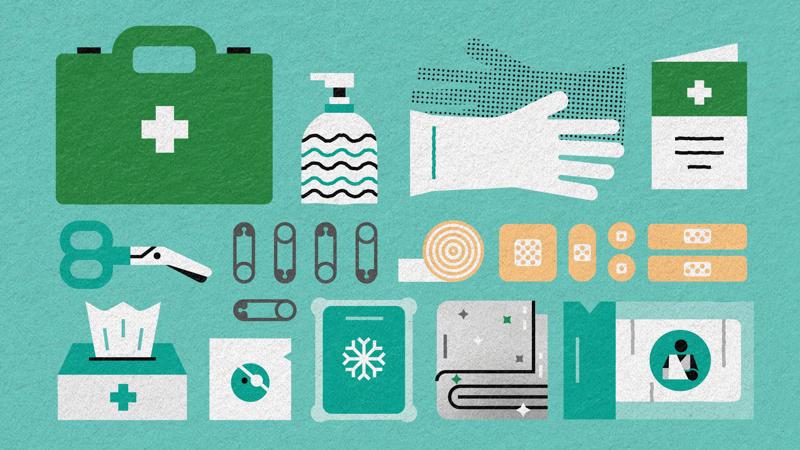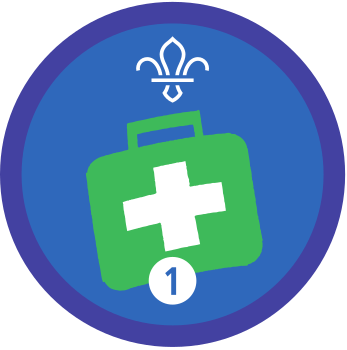
Be an emergency aider: extreme temperatures
You’ll need
- Tables
- First aid supplies (including blankets, a silver blanket, a fan, and water)
Before you begin
- Make sure the person leading the activity knows about first aid. Someone from your group or local area with a first aid certificate could take charge, or you could reach out to places that help provide first aid training or support, for example, St John Ambulance or the British Red Cross.
- You’ll need enough leaders for the activity, including enough people who are happy to demonstrate first aid techniques.
- Adults should only demonstrate and practise first aid on other adults; young people should only demonstrate and practise first aid on other young people. Adults and young people should never demonstrate or practise first aid on each other.
- This activity has four bases – if you’re short on space, have two bases (one for heat and one for cold).
- Divide the room into four bases and place a table in each area. Each table should represent a condition that is a result of being too hot and cold including; hypothermia, frost bite, heat exhaustion, heat stroke and dehydration, but pair up heat stroke and heat exhaustion to create four topic areas.
- Print out the information from each of the accordions below and place it and the relevant equipment for each condition on separate tables
Explain the bases
- Explain to everyone that this activity’s all about the effects of hot and cold. Everyone should think of conditions that happen when someone gets too hot or cold. Help everyone name hypothermia, frostbite, heat exhaustion, heatstroke, and dehydration if needed.
- Everyone should split into four groups.
- Each group should go to a different base and get stuck in. After about 10 or 15 minutes, the person leading the activity should make a signal and everyone should move to the next base.
- Everyone should continue to move to the next base every 10 to 15 minutes, until they’ve visited all of the bases.
Hypothermia’s a condition that happens when someone gets too cold. Our bodies are usually around 37 degrees – hypothermia happens when someone’s body temperature drops below 35 degrees. It can quickly become life-threatening, so it’s important to treat someone with hypothermia right away.
Signs and symptoms of hypothermia include:
- shivering, cold and pale with dry skin
- unusually tired, confused and have irrational behaviour
- reduced level of response
- slow and shallow breathing
- slow and weakening pulse
Treating hypothermia’s all about warming the casualty’s body up again. The exact steps will depend on where you are (and what you have available) – if you’re halfway up a mountain, you probably won’t be able to pop inside with your casualty, but if you’re camping behind your usual meeting place, it’s probably the easiest option.
Generally, treating hypothermia is about getting the casualty somewhere warm, replacing wet clothes, wrapping them in blankets, giving them a hot drink, and calling 999. People could practise protecting a casualty from the ground with insulating material, making them a warm drink, or pretending to call 999 while monitoring the casualty. You can find exact steps on the St John Ambulance website.
Frostbite happens when someone’s body is exposed to the cold for too long. Their skin (and other tissues) freeze and lose sensation; the tissues can then die and it can lead to gangrene.
Signs and symptoms of frostbite include:
- pins and needles
- paleness of the area and numbness
- hardened and stiffened skin
- colour change to the skin. The skin may change from white to mottled and blue. On recovery, the skin may be red, hot, painful and blistered. When gangrene occurs, the skin may become black due to the loss of blood supply.
Treatment for frostbite involves getting the casualty to somewhere warm and gently warming the affected part. People could practise gently warming a friend’s hand following the St John Ambulance advice, dressing it, and raising it. They could also practise by pretending to call 999. You can find exact steps on the St John Ambulance website.
Dehydration happens when someone loses too much fluid without replacing it. People lose fluid by sweating during exercise, being in the sun (or humid conditions) for too long, swearing from a raised body temperature (like a fever), diarrhoea, and vomiting. If dehydration’s left untreated, the casualty may develop heat exhaustion.
Signs and symptoms of dehydration include:
- a headache or lightheadedness
- dizziness or confusion
- a dry mouth and dry eyes
- dry or cracked lips
- reduced amounts of dark urine
- muscle cramps, such as to the calves
You should pay special attention to babies and young children. They may also have pale skin with sunken eyes and if they’re dehydrated their condition can get worse very quickly.
The basic treatment for dehydration is to help the person replace the lost fluids by drinking. People could practise explaining why someone needs to sit down, rest, and drink water. They could also practise by pretending to seek medical advice. You can find exact steps on the St John Ambulance website.
Heat exhaustion’s usually caused by someone losing salt and water – it usually happens to people who aren’t used to hot, humid weather. Heatstroke happens when the part of the brain that regulates the body’s temperature fails and the body’s unable to cool down. It can come after heat exhaustion, or can be caused by spending too much time in the sun, having a high fever, or taking non-prescription drugs such as ecstasy.
Signs and symptoms of heat exhaustion include:
- a headache, dizziness and confusion
- a loss of appetite and feeling sick
- sweat with pale, clammy skin
- cramps in the arms, legs and stomach
- a fast, weakening pulse and breathing
Signs and symptoms of heatstroke include:
- headache, dizziness and discomfort
- they may be restless and confused
- hot, flushed and dry skin
- becoming less responsive quickly
- pulse that’s full and bounding
- body temperature above 40 degrees
Treating heat exhaustion is all about getting the casualty to a cool place, helping them to lie down and raise their legs, and giving them water. Treating heatstroke is about getting the casualty to a cool place, helping them cool down, and monitoring them until help arrives. People could practise wrapping people in a sheet, monitoring a casualty, or pretending to call 999. You can find exact steps for heat exhaustion and heatstroke on the St John Ambulance website.
Reflection
This activity was all about being responsible. People learned how heat and cold affect the body. Does anyone think knowing this will help them to recognise warning signs in themselves and others? Why may it be helpful for people to be aware of their bodies and how they’re responding? People could think about how they could begin to help themselves or others sooner, before conditions develop or get worse.
People also developed skills in this activity. What did they learn about spotting symptoms? People right remember that there was sometimes overlap in symptoms, because the body was trying to deal with similar circumstances. Can anyone think of other situations where they may need to deal with a body’s reaction? People could think about shock, when it could happen, and what they’d do. When might people put their emergency aid skills to use? People could think about where heat exhaustion or hypothermia may be most likely – they’re not everyday problems, but they may crop up on holidays, day trips, or even enjoying the local park in the summer.
Safety
All activities must be safely managed. You must complete a thorough risk assessment and take appropriate steps to reduce risk. Use the safety checklist to help you plan and risk assess your activity. Always get approval for the activity, and have suitable supervision and an InTouch process.
If anyone can’t reach their casualty, or is unable to do things like helping them move, they can still learn so they can instruct others. They may want to get into a group of three, so they can tell a third person what to do to help the casualty.
All Scout activities should be inclusive and accessible.
Put people’s skills to the test by creating some scenarios in your meeting place. Once groups enter, they’ll need to do a primary survey to work out what they need to do. You could also combine the skills people learned in this activity with other emergency aid skills and organise an incident hike.
Young people with first aid qualifications could help others if they’re struggling, with a leader supervising.
